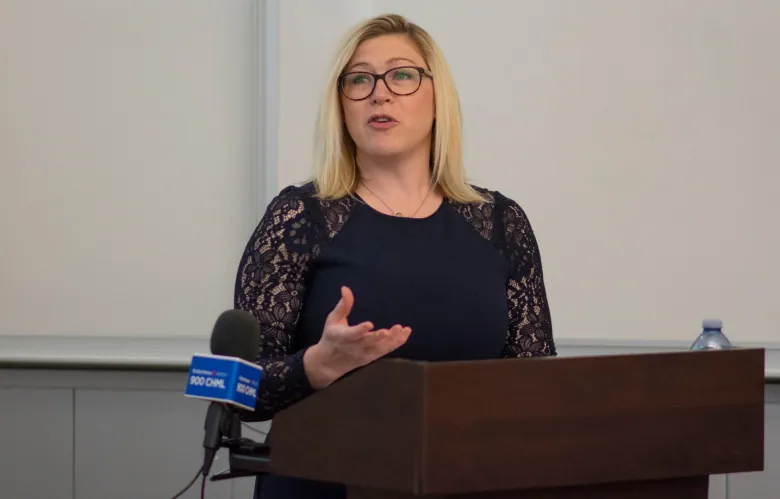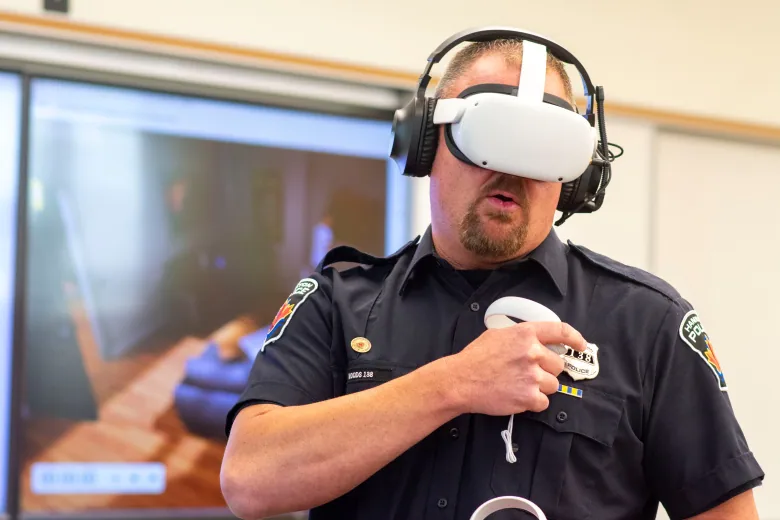Const. Scott Woods is standing in the doorway talking to a man named Jamie.
Jamie is home alone at a rooming house and is petrified. He tells Woods there are people outside who attacked him.
Jamie has wounds to his face and sore ribs, he lives with PTSD and he smoked marijuana before Woods arrived.
Police dispatchers also told Woods that Jamie has a history of possession of drugs, resisting arrest, theft and mental health issues.
Then Jamie picks up a baseball bat. “They’re coming back to get me!” he yells at Woods.
Moments later, Woods calms Jamie without the use of force. Then Woods takes off his virtual reality headset.
Woods is a real officer with the Hamilton Police Service, but everything else was a simulation.

It’s part of Hamilton Police Service’s new Mental Health Crisis Response Training Program and is designed to help teach police officers to recognize the signs of a mental health crisis and improve how they de-escalate situations.
The program is the product of six years of work by Wilfrid Laurier University researcher Dr. Jennifer Lavoie and Toronto Metropolitan University researcher Dr. Natalie Alvarez which compares the effectiveness of live-action training against virtual reality.
Lavoie said it also included consultations with health-care professionals, community groups, people living with mental illness, anti-discrimination experts, police instructors and people who’ve had police knock on their door.
“They have that lived experience and sometimes, it doesn’t go well, often it doesn’t go well. We have to acknowledge those shortcomings and those experiences and they have to be authentically incorporated,” Lavoie said.
“We’re here to change the way police respond … we’ve all seen the statistics, we know people with histories of mental illness are more likely to be injured or killed.”
Lavoie also said the training was developed in direct response to Sammy Yatim’s death.
Former Toronto police officer James Forcillo shot the teenager on a TTC streetcar in 2013. Forcillo was convicted of attempted murder in 2016 and began serving prison time in November 2017 but was granted full parole in 2020.
The shooting led Ontario ombudsman Paul Dubé to issue a scathing review of police training in Ontario, calling for officers to get better de-escalation training.
It also spurred former Supreme Court justice Frank Iacobucci to make 84 recommendations for police.
“We know most officers are not particularly well trained in responding to mental health crisis scenarios,” Lavoie said.
‘Choose your own adventure’ training
Lavoie said the training is like a “choose your own adventure” for officers as they can react however they want and the simulation — controlled by the trainer — will escalate accordingly.
For example, if an officer decided to point a gun at Jamie after he picked up a bat, the trainer could pause the scenario and use it as a moment to teach the officer what they should do instead.
Lavoie said there are six situations VR-ready right now. Three are 90-minute exercises and three are 10-minute assessments where an officer in training gets a score at the end.
The settings include a home, an emergency room and a park. Lavoie said there is also diversity within the scenarios, pointing to a situation which involves an Indigenous person who is hallucinating and another which includes a youth who is transitioning to a different gender.
“They have to know how to respond to all members of our community,” she said.
The ultimate goal goes beyond seeing better training scores over time.
“What we would be looking for is fewer injuries, fewer use of force incidents, better referrals to services. We’d want to see it in police practice,” Lavoie said.

Dr. Katy Kamkar, a clinical psychologist in Toronto with the Global Law Enforcement and Public Health Association, isn’t affiliated with the training said the program sounds promising.
She pointed to virtual reality’s use in therapy for anxiety disorders.
“It helps to release a physiological reaction … it helps us to be in that mode, in that situation,” Kamkar said in a phone interview on Thursday morning.
“Anything we can utilize to optimize education, training, building knowledge [and confidence] … it’s a great tool,” she said, adding it’s important to back up with further research.
Hamilton police already has programs like COAST, a mobile rapid crisis response team, a rapid intervention support team and the social navigator program.
It’s also the first police service in Ontario to offer the program, joining just weeks ago.
Lavoie said while her study to determine if live action is better than virtual reality will be complete soon, we know that virtual reality is much more affordable and readily accessible.
The program is licensed and free for municipal and First Nations police services in Ontario.
Lavoie said she is confident others will take on the training program soon, leading to standardized training across the province.
Reference-www.cbc.ca